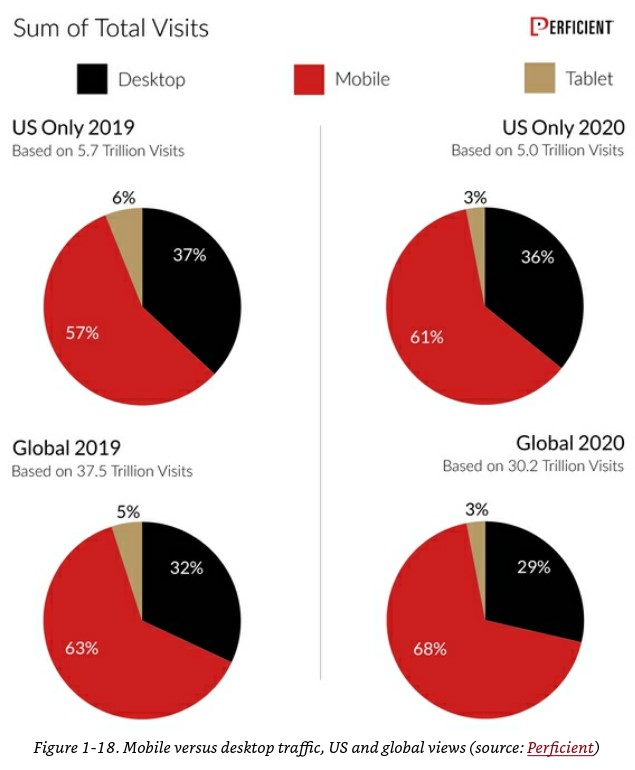Early SEO and Focus on Desktop
SEO (Search Engine Optimization) used to focus a lot on desktop searches back in the early days of the internet. Focusing on things like keyword density, meta tags, and backlinks, the tactics were all about making websites work better for desktop users. Desktop searches ruled the market, and getting high rankings on Yahoo!, AltaVista, and then Google was the main goal.
Make the switch to mobile SEO
When smartphones came out, they completely changed the SEO world. As more people used phones, SEO tactics had to change to make sure websites worked well on phones. A study by Perficient, showed that 70% of all traffic comes from mobile devices.

Google’s launch of mobile-first search made this change even clearer, making it necessary for websites to work perfectly on phones.
Some important changes were:
– Responsive Design: Making sure that websites change themselves to fit different screen sizes.
– Page Speed: People who use mobile devices expect pages to load quickly. Google’s PageSpeed Insights became an important tool for making load times faster.
Optimizing for local search results has become very important as the number of mobile searches has grown, especially for local companies. This meant making and optimizing Google My Business entries, getting local backlinks, and making sure that the NAP (Name, Address, Phone number) was always the same.
Voice Search and Search Engine Optimization
Voice search was made possible by voice-activated devices like Siri, Google Assistant, and Alexa. This made SEO even more complicated. Language and conversational keywords are important for voice search SEO because people talk queries differently than they type them.
Some strategies are:
When it comes to long-tail keywords, you should focus on using more natural, casual language.
– Featured Snippets: Making content better so it shows up in “position zero” for quick replies.
– Local Optimization: A lot of voice searches are for things “near me,” which makes local SEO even more important.
What are the latest SEO trends for different devices?
- “Mobile-First Indexing” means that Google mostly uses the mobile version of the material to rank and index it. All of this means that websites need to be mobile-friendly. It is important to have a design that works well on mobile devices, run quickly, and be easy to navigate.
- Speech Recognition: As voice search grows, material needs to be made better for voice queries. To do this, you should use natural English, answer questions directly, and focus on local SEO. Structured data, such as style markup, can help search engines better understand what the content is about.
- Desktop SEO: Even though mobile is growing, desktop is still important, especially for shopping and doing in-depth research. Desktop SEO is all about having detailed content, strong backlink profiles, and thorough search strategies. Making sure PC users have a great experience is still very important. Desktop delivers the most total time on site (also known as “dwell time”) from visitors in aggregate, and nearly the same number of page views as mobile devices.
- AI and Personalization: AI is having a bigger effect on SEO. Google’s AI models, such as BERT and MUM, try to understand what is going on and give you more relevant search results. This means that SEO needs to think about user purpose and context even more than before. It is very important to make content that is high-quality, relevant, and meets the wants of specific users.
What the Future Holds for SEO in Light of New Trends
Continued Dominance of Mobile
Mobile devices will probably continue to be the most popular way to find the internet. Mobile optimization must stay at the center of SEO strategies:
– Mobile-First Design: Making sure that new websites are made with mobile users in mind.
– Accelerated Mobile Pages (AMP): Making sure that mobile pages load faster by using AMP.
– Mobile User Experience: Making it easier to use mobile devices by making the design natural and the navigation simple.
Voice Search’s Growth
Voice search is likely to become more common, which means that SEO will need to change even more:
– Conversational Content: making content that sounds like real speech.
– Answer optimization means setting up content to directly answer common questions, which increases its chances of showing up in voice search results.
– Local SEO Focus: Making local SEO efforts stronger to get local voice search questions.
The ability to work with other technologies
Things like AR and IoT will mean that SEO will have to change:
– Visual Search Optimization: It will be more important to optimize images and other visual material as visual search grows. It is important to use alt text, picture sitemaps, and high-quality images.
– IoT Integration: Devices that are linked through IoT will give SEO new sources of info. Figuring out how people use these devices can help you make the material and experience better for them.
AI and better personalization
AI will be used more to make search results more relevant to each person. This is what SEO plans need to pay attention to:
– User Intent: Learning about and guessing what users want so you can make content that meets their needs.
– Content Relevance: Making sure that the content you create is of high quality, dependable, and directly meets the wants of your users.
– Behavioral data is information about how people use a website that can be used to improve and focus SEO efforts.
Advice on how to plan your SEO strategy
- Take a “multi-device” approach: Make sure that your SEO plans work for both PC and mobile users. Even though mobile optimization is very important, do not forget about the desktop experience, especially for certain types of users and businesses.
- To make your site better for voice search, write it in a chatty style, focus on long-tail keywords, and make sure it is set up to directly answer questions. Use schema markup to make information more visible in voice search results.
- Use AI Tools: Use SEO tools that are driven by AI to learn more about how users behave, find new keyword opportunities, and make content more relevant and easy to understand.
- Focus on Local SEO: To get more business from mobile and voice searches, make your local SEO efforts stronger. Get local reviews, make sure your business pages are correct and consistent, and make sure they are optimized for local keywords.
- Get ready for new technologies: To stay ahead, look into how new technologies like AR and IoT can be added to your SEO plan. Make sure your visual content is optimized for visual search and keep an eye on how IoT data can help your SEO.
- Create High-Quality, Relevant Content: Make content that helps people your top priority. This includes in-depth, well-researched articles, interesting multimedia, and material that answers specific questions and meets specific needs of users.
Final Thoughts
The past of internet searches by device type shows how quickly people are switching from desktops to phones and how important voice search is becoming. Because of these changes, SEO strategies have changed too. Now, they rely on mobile-first design, voice search optimization, and adding AI. With an eye on the future, we can see that SEO tactics will continue to change as mobile devices continue to rule, voice search grows, and new technologies like AR and IoT are added. Businesses can make sure they stay visible and competitive in the ever-changing digital world by being flexible and focusing on high-quality, relevant material.
